
Demographics of Libya is the demography of Libya, specifically covering population density, ethnicity, education level, health of the populace, economic status, and religious affiliations, as well as other aspects of the Libyan population. The Libyan population resides in the country of Libya, a territory located on the Mediterranean coast of North Africa, to the west of and adjacent to Egypt. Libyans live in Tripoli. It is the capital of the country and first in terms of urban population, along with Benghazi, Libya's second largest city.

Fezzan is the southwestern region of modern Libya. It is largely desert, but broken by mountains, uplands, and dry river valleys (wadis) in the north, where oases enable ancient towns and villages to survive deep in the otherwise inhospitable Sahara Desert. The term originally applied to the land beyond the coastal strip of Africa proconsularis, including the Nafusa and extending west of modern Libya over Ouargla and Illizi. As these Berber areas came to be associated with the regions of Tripoli, Cirta or Algiers, the name was increasingly applied to the arid areas south of Tripolitania.

Ubari or Awbari is a Tuareg Berber–speaking oasis town and the capital of the Wadi al Hayaa District, in the Fezzan region of southwestern Libya. It is in the Idehan Ubari, a Libyan section of the Sahara Desert. It was the capital of the former baladiyah (district) called Awbari, in the southwest of the country.
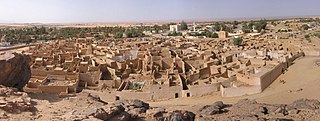
Ghat is the capital of the Ghat District in the Fezzan region of southwestern Libya, located just east of the Algerian border.

Murzuk, Murzuq, Murzug or Merzug is an oasis town and the capital of the Murzuq District in the Fezzan region of southwest Libya. It lies on the northern edge of the Murzuq Desert, an extremely arid region of ergs or great sand dunes which is part of the greater Sahara Desert.

Ghadames or Ghadamis is an oasis town in the Nalut District of the Tripolitania region in northwestern Libya.

The Toubou or Tubu are an ethnic group native to the Tibesti Mountains that inhabit the central Sahara in northern Chad, southern Libya, northeastern Niger and northwestern Sudan. They live either as herders and nomads or as farmers near oases. Their society is clan-based, with each clan having certain oases, pastures and wells.
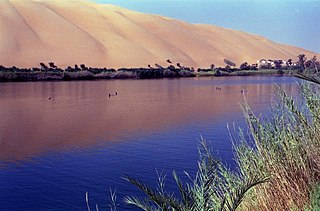
Gaberoun is an oasis with a large lake in the Idehan Ubari desert region of the Libyan Sahara. Administratively it is located Wadi al Hayaa District of the Fezzan region in southwestern Libya.

Ghat is one of the districts of Libya. Its capital is Ghat. To the west, Ghat borders two provinces of Algeria: Tamanghasset in the far southwest, and Illizi Province. It also has a short border with the Agadez Department of Niger in the far south. Domestically, it borders Wadi Al Shatii in north, Wadi Al Hayaa in northeast and Murzuq in the east.
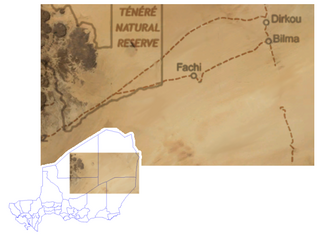
Dirkou is a town in the Bilma Department, Agadez Region of north-eastern Niger. It lies in the northern Kaouar escarpment, a north–south line of cliffs which form an isolated oasis in the Sahara desert. As of 2011, the commune had a total population of 14,998 people. Apart from the main city of Dirkou, the rural communities of Achénouma, Aney, and Emi Tchouma lie within the borders of the commune.
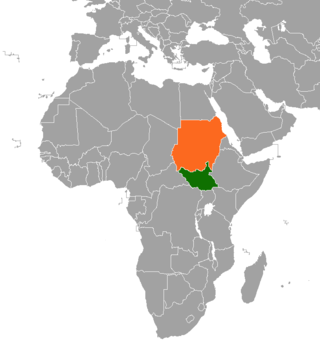
Sudanese nomadic conflicts are non-state conflicts between rival nomadic tribes taking place in the territory of Sudan and, since 2011, South Sudan. Conflict between nomadic tribes in Sudan is common, with fights breaking out over scarce resources, including grazing land, cattle and drinking water. Some of the tribes involved in these clashes have been the Messiria, Maalia, Rizeigat and Bani Hussein Arabic tribes inhabiting Darfur and West Kordofan, and the Dinka, Nuer and Murle African ethnic groups inhabiting South Sudan. Conflicts have been fueled by other major wars taking place in the same regions, in particular the Second Sudanese Civil War, the War in Darfur and the Sudanese conflict in South Kordofan and Blue Nile.

The 2011 Sabha clashes were a series of clashes between forces loyal to Libyan leader Muammar Gaddafi and rebel anti-Gaddafi forces for control of the desert oasis city of Sabha and a part of the Libyan Civil War which took place during June 2011.
The Battle of Sabha took place between forces loyal to Libyan leader Muammar Gaddafi and rebel anti-Gaddafi forces for control of the desert oasis city of Sabha and a part of the Libyan Civil War. It was the second conflict in the city since the start of the war after the 2011 Sabha clashes.
The Fezzan campaign was a military campaign conducted by the National Liberation Army to take control of southwestern Libya during the Libyan Civil War. During April to June 2011, anti-Gaddafi forces gained control of most of the eastern part of the southern desert region during the Cyrenaican desert campaign. In July, Qatrun changed to anti-Gaddafi control on 17 July and back to pro-Gaddafi control on 23 July. In late August, anti- and pro-Gaddafi forces struggled for control of Sabha.
The 2012 Sabha conflict started in the aftermath of the Libyan civil war, and involved armed clashes between the Tubu and Abu Seif tribes in Sabha, a city of almost 100,000 in the region of Fezzan, Libya. It happened after February 2012 clashes in Kufra, that involved the Tubu people, too. On 27 March, Jomode Elie Getty charged the clashes as "genocide". A Paris-based Tabu official, Jomode Elie Getty, who was an official with the NTC but resigned on Tuesday, accused the NTC of siding with Arabs in attacks on Tabu tribesmen. He called for U.N. intervention.
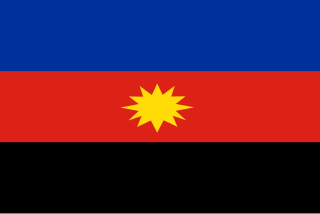
The Toubou Front for the Salvation of Libya is a group created in mid-2007 to defend the rights and interests of the Toubou people in Libya. It is led by Issa Abdel Majid Mansur, a Libyan Toubou tribal leader, and has its headquarters in Oslo, Norway. The group, which had participated in the Libyan Civil War on the NTC side, was disbanded in August 2011, with the fall of Tripoli. Despite that, the group was revitalized in March 2012, with the aim of "protecting the Toubou from ethnic cleansing", following early 2012 deadly clashes between Toubou and Arab militias in southern Libya, which caused the loss of hundreds of lives.

Tuareg militias of Ghat (TMG) are ethnic Tuareg tribal militias, operating in South-West Libya desert areas during the Second Libyan Civil War. The militias rose to prominence in the district of Ghat, which has a Tuareg majority. Gradually, the Tuareg forces expanded their hold also into neighbouring districts. The Libyan Tuaregs are supported by Tuaregs of Mali and groups like Ahmed al-Ansari, with support from the Misratan Libyan Dawn forces. Tuareg militias often utilize the Berber flag.

In late January 2019, the Libyan National Army (LNA) led by Marshal Khalifa Haftar launched an offensive to take control of the city of Sabha and the rest of southern Libya from the internationally recognised Government of National Accord (GNA) and local factions. Officially, the LNA announced that the reason for the operation was to remove terrorists, Chadian rebel groups, and to secure the border, but it has expanded Haftar's territorial control and acquired him oil fields near Sabha. It has also restarted some interethnic conflicts as the LNA has allied with local Arab tribes, while the Tuareg and Toubou tribal militias are loyal to the GNA.

Lev Leonidovich Dengov is a Russian-Belarusian entrepreneur and businessman. Chairman of the Board of the Russian-Libyan Trade House.
Ali Kanna Sulayman is a Libyan lieutenant general of Tuareg origin. He was the commander of Muammar Gaddafi's southern forces in the First Libyan Civil War. After the end of the Fezzan campaign, he fled to Agadez and helped other Gaddafi loyalists, most notably air force commander Ali Sharif Al-Rifi, escape to Niger.
















